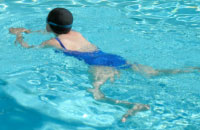Peritoneal Dialysis: Questions & Answers
Will a peritoneal dialysis (PD) catheter set off an airport metal detector? Can you be intimate with your partner while using a PD cycler? Will your hair grow back in if it's been falling out? We've found the answers to some tricky PD questions, so look no further!

- Q: Will a PD catheter set off an airport metal detector?
- A: No. There is not enough metal in a PD catheter to be a problem for you. Even a steel plate in an ankle won't do the trick—though a total knee or hip joint replacement most likely will. 1
- Q: Can I be intimate with my partner while I'm on a cycler?
- A: Yes. Just be sure that your catheter is well-taped, and safe from pulling or tugging. Or, you can fill, disconnect, and then reconnect before the drain cycle starts. (Some people do this to watch TV or do other evening tasks, too.)
- Q: My hair has thinned. Will it grow back?
-
A: In most cases, yes. It is normal for about 1 in 10 hair follicles to be shedding (that's 10,000 hairs) at any one time.
2
In the months before kidney failure, two factors may speed up hair loss:
- Not eating enough protein (hair is made of protein)
- Anemia (a shortage of red blood cells)
- Vitamin A level
- Too-high levels can block hair growth. 3
- Thyroid hormone level
- Too-low levels may be a problem. 4
- Blood-thinning medicine
- This is more of a problem on hemodialysis, but some types of heparin (low molecular weight) have been linked to hair loss. 5
- Q: Should I panic if I see blood in a drain bag?
-
A: No. Call your PD nurse, but keep in mind that a little blood can go a long way to color a bag. Very rarely, blood in a PD bag can mean peritonitis. 7 If you have fever, pain, and/or the drain bag is also cloudy, this is worth checking.
Most often a bit of blood in a bag means that you:
- Have broken a capillary blood vessel. 7
-
This can happen due to:
- Vigorous exercise
- Vomiting
- The tip of the catheter rubbing
- A nasty cough
- Are a woman and have (or will soon get) your period. 7
- Sometimes blood can migrate into the peritoneum.
If you keep having bloody bags, ask your doctor to do a more-thorough look to rule out other problems. There was one report in a published paper about a case of liver cancer that was caught early enough to treat successfully, due to blood in a PD bag. 8
- Q: How can I eat enough protein?
-

A: Unlike the tiny nephrons that filter blood in the kidneys, the peritoneum is "leaky" to protein. As a plus, this means PD is the only treatment that removes protein-bound wastes, like P-cresol (which can cause heart disease in people who don't have diabetes). 9 But, it also means you lose more protein, so you need to eat more.
Crawfish Photo by Joonas Lyytinen
Malnutrition (a serum albumin level <3.5 g/dL) can shorten your life. If it's hard to get yourself to eat protein, here are some tips that may help:
- Eat protein first, so if you run out of appetite, at least you've eaten that.
- If hot foods don't appeal, try cold ones—like egg, tuna, or chicken salad.
- Read food labels: sprouted grain breads taste great and have much more protein.
- Add tasteless protein powder (such as powdered eggwhites – you can find them here) where you won't notice it: to soups, stews, juices, smoothies...
- Can't face a large meal? Try having several smaller ones, with protein snacks (deviled eggs; roast beef or low-sodium ham or turkey wrapped around string cheese; smoked salmon wrapped around cucumber).
- Ask your PD nurse about Nutrineal PD fluid, which has amino acids that form protein.
- Q: How can I stop cycler drain pain?
-
A: Some people on PD don't feel anything when a cycle ends. Some have a bit of a pinch. And some have enough pain when their fluid levels get very low that they may even want to stop doing PD. For most, leaving a bit of fluid in the belly—called Tidal PD—will help. Tidal PD can also help if your pain is caused by a catheter tip that rubs against your internal organs when you are empty.
Changing your position in bed may help, too. Try turning from your back to your side, or from side to side.
- Q: Can I swim or take a tub bath safely?
-

A: As you know, a PD catheter is a pathway into your peritoneum—which is meant to be sterile. Allowing any germs to get in means that you risk peritonitis. Some PD programs handle this by forbidding swimming. If your program does this, you need to respect their rules—or find another program.
If your program supports swimming, they will ask you to swim in an ocean (the salt kills germs) or a very chlorinated private pool. 10 Fresh water, like rivers or lakes, or public pools grow too many germs to be safe for you on PD. Your catheter exit site needs to be fully healed, too. Some researchers believe a Tegaderm® dressing 11 or a water-proof ostomy dressing 12 over the exit site may reduce the risk of infection.
Tub or hot tub bathing is not a good choice for you if your PD catheter is in your abdomen. A presternal PD catheter 13 is a safer option for bathing. Since it is placed in the chest, you can keep the exit site out of the water.
Conclusion
We hope these answers will ease your mind and help you overcome some PD challenges, so you can keep making PD work for you.
References:
- Ramirez MA, Rodriguez EK, Zurakowski D, Richardson LC. Detection of orthopaedic implants in vivo by enhanced-sensitivity, walk-through metal detectors. J Bone Surg Am. 2007 Apr;89(4):742-6.
- The World of Hair , an online reference by Dr. John Gray, provided by the P&G Hair Care Research Center.
- Shmunes E. Hypervitaminosis A in a patient with alopecia receiving renal dialysis. Arch Dermatol. 1979 Jul;115(7):882-3.
- Galamb L, Mako' J, Renyi-Vamos F, Balogh F. [Hair loss following chronic hemodialysis] [Article in German]. Z Urol Nephrol. 1984 Aug;77(8):491-4.
- Egfjord M, Rosenlund L, Hedegaard B, Buchardt HL, Stengel C, Gardar P, Anderson L, Anderson L. Dose titration study of tinzaparin, a low molecular weight heparin, in patients on chronic hemodialysis. Artif Organs. 1998 Aug;22(8):633-7.
- Whitwam W, Lewis M, Rabb H. Alopecia in three women of Southeast Asian descent with chronic renal failure: possible association with erythropoietin use. Am J Kidney Dis. 2001 Jan;37(1):E9.
- Lew SQ. Hemoperitoneum: bloody peritoneal dialysate in ESRD patients receiving peritoneal dialysis. Perit Dial Int. 2007 May-Jun;27(3):226-33.
- Dozio B, Scanziani R, Rovere G, Sangalli L, Sacerdoti S, Surian M. Hemoperitoneum in a continuous ambulatory peritoneal dialysis patient caused by a hepatocarcinoma treated with percutaneous embolization. Am J Kidney Dis. 2001 Sep;38(3):E11.
- Meijers BK, Bammens B, De Moor B, Verbeke K, Vanrenterghem Y, Evenepoel P. Free p-cresol is associated with cardiovascular disease in hemodialysis patients. Kidney Int. 2008 M day;73(10):1174-80.
- Take a dip , an article from Truth About Dialysis.
- Plante B, Amadai M, Herbert E, O'Regan S. Tegaderm dressings for peritoneal dialysis and gastrojejunostomy catheters in children. Adv Perit Dial. 1990;6:279-80.
- Sandahl LL, Owens EL. Use of an ostomy pouch for pediatric CAPD swimmers. ANNA J. 1989 Jun;16(4):274-7.
- The 'Bathtub' Presternal PD Catheter, an article from Home Dialysis Central.

